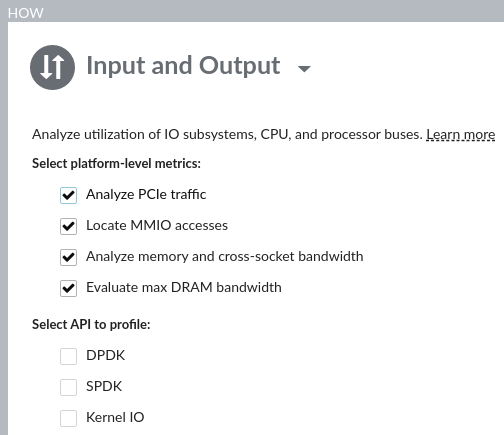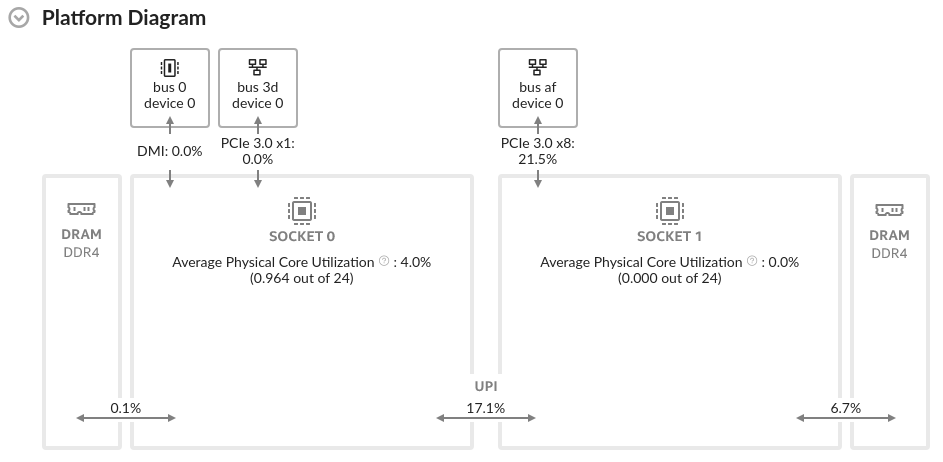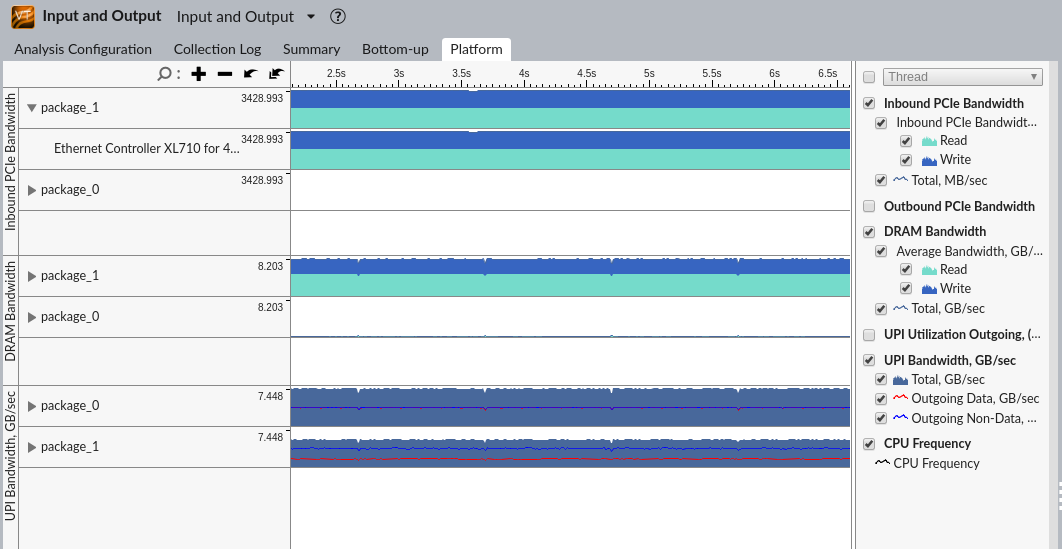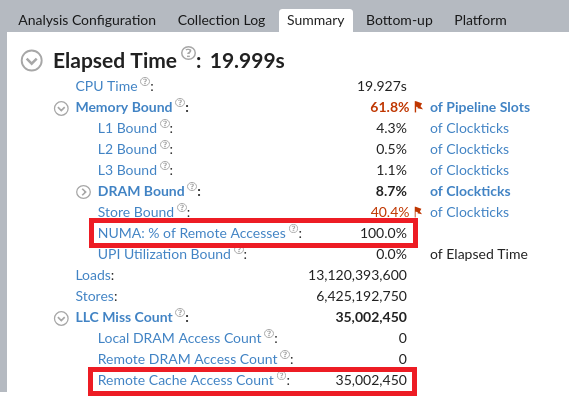Effective Utilization of Intel® Data Direct I/O Technology
This recipe demonstrates how Intel® VTune™ Profiler reveals the utilization efficiency of the Intel® Data Direct I/O technology, a hardware feature of Intel® Xeon® processors.
Content experts: Ilia Kurakin, Perry Taylor
Traditionally, inbound PCIe transactions target the main memory, and data movement from the I/O device to the consuming core requires multiple DRAM accesses. For I/O-intensive use cases, such as software data planes, this scheme becomes inapplicable.
For example, when a 100G NIC is fully utilized with 64B packets and 20B Ethernet overhead, new packet arrives, on average, every 6.72 nanoseconds. If any component on the packet path takes more than this small timeframe to process this individual packet, packet loss occurs. For a core running at 3GHz, 6.72 nanoseconds only accounts for 20 clock cycles, while DRAM latency is on average 5-10 times higher. This is the main bottleneck of the traditional DMA approach.
Intel® DDIO technology is a hardware feature of Intel® Xeon® processors that eliminates this bottleneck by allowing PCIe devices to perform read and write operations directly to and from the L3 cache (also known as LLC — last-level cache). This places the incoming data as close to the cores as possible. When the Intel DDIO technology is properly utilized, core and I/O device interactions can be served by using the L3 cache only, completely removing the need for DRAM accesses. This creates the following advantages:
Low inbound read and write latencies that allow for high throughput.
Reduced DRAM bandwidth and power consumption.
Though Intel® DDIO is a hardware feature that is always enabled and transparent to software, there are pitfalls that may lead to non-optimal performance.
There are two main software tuning opportunities for optimizing Intel® DDIO utilization:
Topology configuration: for a system with multiple sockets, it is critical that the I/O device, the core that interfaces with the I/O device, and the memory are on the same NUMA mode.
L3 cache management: advanced tuning helps optimize L3 cache usage by keeping the necessary data available in the L3 cache at the right time.
This recipe demonstrates how to detect inefficiencies in Intel® DDIO technology utilization using the Input and Output analysis in VTune Profiler.
Directions:
Ingredients
System: a two-socket 2nd Generation Intel® Xeon® Scalable processor-based system.
Application: DPDK testpmd application configured to run on a single core and to perform packet forwarding using one port of one 40G network interface card attached to Socket one.
Performance Analysis Tool:Intel® VTune™ Profiler 2020 Update 2: Input and Output analysis.
NOTE:Starting with the 2020 release, Intel® VTune™ Amplifier has been renamed to Intel® VTune™ Profiler.
Most recipes in the Intel® VTune™ Profiler Performance Analysis Cookbook are flexible. You can apply them to different versions of Intel® VTune™ Profiler. In some cases, minor adjustments may be required.
Get the latest version of Intel® VTune™ Profiler:
From the Intel® VTune™ Profiler product page.
Download the latest standalone package from the Intel® oneAPI standalone components page.
Understand the Architectural Background
In Intel® Xeon® Scalable processors, the L3 cache is a resource that is shared between all cores and all Integrated I/O controllers (IIO) within one socket. Data transfers between the L3 cache and the cores are performed with cacheline granularity (64B). When a PCIe device makes a request to the system memory, IIO translates this request into one or multiple cache line requests and issues them to the L3 cache on the local socket. A request to local L3 cache can carry out in these ways:
Inbound PCIe write request
Inbound PCIe write L3 hit — ideal scenario — occurs when an address targeted by a write request is already cached in the local L3. The cache line in the L3 is then overwritten with the new data.
Inbound PCIe write L3 miss — non-ideal scenario — occurs when an address targeted by the write request is not cached in the local L3. In this case, a cache line is first evicted from an L3 way dedicated for I/O data. This could lead to DRAM write-back if the evicted line was in a dirty state. Then, in place of the evicted line, a new cache line is allocated. If the targeted cache line is cached remotely, cross-socket accesses through the Intel® Ultra Path Interconnect (Intel® UPI) are required to enforce coherency rules and to complete the cache line allocation. Finally, the cache line is updated with the new data.
Inbound PCIe read request
Inbound PCIe read L3 hit — ideal scenario — occurs when an address targeted by a read request is cached in the local L3. The data is read and sent to the PCIe device.
Inbound PCIe read L3 miss — non-ideal scenario — occurs when an address targeted by a read request is not cached the local L3. In this case, the data is read from the local DRAM or from the remote socket's memory subsystem. No local L3 allocation is performed.
For the 1st and 2nd Gen Intel® Xeon® Scalable processors, the Input and Output analysis of VTune Profiler provides Intel® DDIO utilization efficiency metrics including L3 hit/miss ratios and average latencies of inbound PCIe reads and writes, and supports data breakdown by groups of PCIe devices. These groups are defined by M2PCIe units, which are the interfaces between the IIO controller and the mesh.
Analyze Intel DDIO Traffic
Use the Input and Output analysis of VTune Profiler to collect Intel DDIO utilization efficiency metrics.
To run the analysis, ensure you are using a 1st or 2nd Gen Intel® Xeon® Scalable processors and that the sampling driver is loaded. The recommended minimal collection time is 20 seconds.
To run the analysis:
In the WHAT pane, select Launch Application and specify the path to the application and any parameters, or select Attach to Process and specify the PID. Additionally, you can use the Automatically stop collection after (sec) option to automatically control collection time.
In the HOW pane, select the Input and Output analysis. Check the Analyze PCIe traffic checkbox to collect Intel DDIO utilization efficiency metrics.

Click the
 Start button to run the analysis.
Start button to run the analysis.
Understand Typical Examples
To understand typical inefficient usages of Intel DDIO technology and the capabilities of VTune Profiler that help highlight them, run the DPDK testpmd application on a two-socket system equipped with 2nd Generation Intel® Xeon® Scalable processors. The application is configured to run on a single core and to perform packet forwarding using one port of a single 40G NIC attached to Socket 1.
The traffic generator injects 64B packets into the system with a packet rate that is much higher than one core can process. The optimization criterion is the system throughput: the higher throughput the better. For this configuration, the experiment identifies the single core application throughput.
The data shown here must not be treated as a performance report.
As a single baseline for two examples below, use a configuration where a core from Socket 1 performs packet forwarding. This configuration is called local, since core and PCIe device reside on the same socket:
# ./testpmd -n 4 -l 24,25 -- -i testpmd> set fwd mac retry testpmd> start
Use the mac forwarding mode. In this mode, a core changes the source and the destination Ethernet addresses of packets, thus the forwarding core accesses packet descriptors and touches each packet.
Run VTune Profiler Input and Output analysis and start the result investigation with the Platform Diagram section of the Summary window.
The Platform Diagram shows the system topology and indicates an average utilization of hardware resources: physical cores by computations of the workload being analyzed, DRAM, Intel® UPI and PCIe links. Note that the metric presented for PCIe devices shows the effective link utilization, calculated as portion of physical bandwidth consumed on payloads transferring, while the overhead is not considered. For more details, see the Input and Output analysis section of the User Guide.

In the Summary tab, see the PCIe Traffic Summary section that shows the total inbound and outbound PCIe read and write traffic as first-level metrics, and Intel DDIO utilization efficiency indicators as second-level metrics:
L3 Hit/Miss Ratios represent a portion of inbound requests that hit/miss the L3 cache.
Average Latency shows the average amount of time the platform spent on handling inbound requests for a cache line.
Core/IO Conflicts metric shows the ratio of inbound writes that experience cache line contentions. When detected, VTune Profiler suggests a possible tuning direction.
To see detailed IO metrics, click any metric in the PCIe Traffic Summary section to switch to the Bottom-up pane:

To see PCIe metrics, select the Package/M2PCIe grouping in the Grouping drop-down menu. This grouping breaks down the metrics by sockets and M2PCIe blocks that are named by PCIe devices that they serve. If M2PCIe manages more than one device, device names are given as a comma-separated list. Hover over a cell to see all devices.
To see Intel DDIO utilization efficiency metrics, expand the second level by clicking the Expand button on each column.

Check the Platform tab to see DRAM and Intel UPI bandwidth details.
Remote Socket Accesses
This first experiment demonstrates a non-optimal application topology that results in high DDIO miss rate, higher DDIO latency, and induced DRAM and Intel® Ultra Path Interconnect (Intel® UPI) traffic. Together, all these factors limit performance.
This is an example of a non-optimal topology that uses a remote configuration with the forwarding core and the NIC residing on distinct sockets:
# ./testpmd -n 4 -l 0,1 -- -i testpmd> set fwd mac retry testpmd> start
Now, re-run the analysis in the Attach to Process mode using the graphical interface or the command line:
# vtune -collect io --duration 20 --target-process testpmd
The Platform Diagram immediately reveals issues with topology:
Core utilization on a distinct socket with regard to NIC
Non-zero DRAM and UPI utilization

Explore the results:
| Forwarding core ID | Throughput, Mpps | Inbound PCIe Read L3 Miss, % | Average Inbound PCIe Read Latency, ns | Inbound PCIe Wrie L3 Miss, % | Average Inbound PCIe Write Latency, ns |
|---|---|---|---|---|---|
| 25 | 21.1 | 0 | 112 | 0 | 135 |
| 1 | 17.1 | 100 | 320 | 100 | 240 |
A configuration where the forwarding core and the NIC reside on distinct sockets demonstrates worse performance with a 100% L3 miss rate and higher latency for inbound PCIe requests.
To understand the implications of high miss rates in the remote case, navigate to the Platform pane of the analysis result:

VTune Profiler reports high UPI and DRAM bandwidth. To get a holistic view on what is happening on the system, analyze the configuration from the core perspective by using the Memory Access analysis:
# vtune -collect memory-access -knob dram-bandwidth-limits=false --duration 20 --target-process testpmd

VTune Profiler reports that, in the remote configuration, CPU cores suffer from remote accesses due to LLC misses that get resolved by taking the data from the remote L3 cache. Navigate to the Bottom-up pane to determine which cores, processes, threads, or functions accessed remote LLC:

You can see that all the remote LLC accesses are induced by the testpmd application running on Core 1 from Socket 0.
Now you can recreate what is happening in the remote configuration. Since there is zero DRAM bandwidth on Socket 0, all the memory consumed by the application, used for descriptor and packet rings, is allocated on Socket 1, locally to the NIC. When the forwarding core from Socket 0 accesses descriptors and packets, it misses LLC on Socket 0 and snoop requests are sent to bring the data from Socket 1, which induces UPI traffic. If these requests find modified data in the LLC of Socket 1, DRAM write-back occurs, which contributes to measured DRAM bandwidth.
When the device accesses the same locations again, it misses the L3 cache on Socket 1, because the data was last used by a core on Socket 0 and remains there. So the memory Directory is accessed to determine the socket where the address could be cached, which also contributes to the observed DRAM bandwidth. This time, the snoop requests travel from Socket 1 to Socket 0 to enforce coherency rules and to complete the I/O request.
As a result, you observe the following values captured by Input and Output and Memory Access analyses of VTune Profiler:
| Forwarding core ID | Throughput, Mpps | Inbound PCIe Read L3 Miss % | Average Inbound PCIe Read Latency, ns | Inbound PCIe Write L3 Miss % | Average Inbound PCIe Write Latency, ns | testpmd: LLC Miss Count | testpmd: Remote Cache Access Count | Total DRAM bandwidth (Socket 1), GB/s | Total UPI bandwidth, GB/s |
|---|---|---|---|---|---|---|---|---|---|
| 25 | 21.1 | 0 | 112 | 0 | 135 | 0 | 0 | 0 | 0 |
| 1 | 17.1 | 100 | 320 | 100 | 240 | 35M | 35M | 8 | 12.6 |
In addition to lower throughput caused by higher request latencies, suboptimal application topology causes the system to waste DRAM bandwidth, UPI bandwidth, and platform power.
Poor L3 Cache Management
This second experiment introduces a big variety of non-trivial performance issues, where, even in absence of remote socket accesses, performance is limited due to non-optimal management of I/O data in the LLC, as shown by DDIO misses.
To demonstrate an example using DPDK testpmd, disable software-level caching of memory pools (DPDK Mempool Library) that are used as packet rings. Using this default caching mechanism, a core receives a new packet, and, for the data destination, uses a “warm” memory pool element, which most likely resides in hardware caches. Therefore, there are no L3 misses for Inbound PCIe reads and writes, even with packet ring size going above L3 capacity.
Run testpmd with --mbcache=0 option to disable memory pools software caching:
# ./testpmd -n 4 -l 24,25 -- -i --mbcache=0 testpmd> set fwd mac retry testpmd> start
Compare testpmd performance for the initial local configuration and the same configuration, but with disabled software caching of memory pools:
| Mempool cache enabled | Throughput, Mpps | Inbound PCIe Read L3 Miss % | Average Inbound PCIe Read Latency, ns | Inbound PCIe Write L3 Miss % | Average Inbound PCIe Write Latency, ns | Total DRAM bandwidth (Socket 1), GB/s |
|---|---|---|---|---|---|---|
| Yes | 21.1 | 0 | 112 | 0 | 135 | 0 |
| No | 20.2 | 0 | 115 | 54 | 178 | 4.7 |
When the application is running without memory pool caching optimization, a significant portion of inbound PCIe write requests misses the L3.
To forward one packet, the NIC and the core communicate through the packet descriptor and packet rings. On the data path, the NIC uses inbound PCIe writes to write a packet and update packet descriptors (for more details, see the PCIe Traffic in DPDK Apps recipe).
Descriptor rings are always accessed by a core before I/O, so the probability of an I/O L3 miss on descriptor access is low. But the packet ring is accessed first by the NIC, so all the inbound PCIe write L3 misses are caused by the NIC writing packets to the packet ring at the Rx stage. At the same time, no inbound PCIe read L3 misses are observed, because DPDK follows a zero-copy policy for network data, and once the NIC attempts to take a packet and perform Tx, a packet is already cached.
The conclusions above can easily be made from the experiment statement: with packet ring software caching disabled, packet ring accesses should suffer from hardware cache misses. However, this recipe demonstrates how, in a real-life scenario, you can understand what data was accessed by I/O, resulting in a DDIO miss.
The implications of inbound PCIe request L3 misses in this case are the DRAM bandwidth induced by write-backs from the L3, L3 allocations, and memory Directory accesses.
Key Take-Aways
Intel® DDIO technology enables software to entirely utilize high-speed I/O devices. However, software may not fully benefit from Intel DDIO due to a suboptimal application topology in NUMA systems and/or poor management of data in the L3 cache, leading to high L3 access latencies and unnecessary DRAM traffic. The various analysis types (Input and Output, Memory Access and Microarchitecture Exploration) of VTune Profiler highlight such inefficiencies, creating a holistic picture from both core and I/O perspectives.
While the problem of a wrong application topology has an obvious solution, developing an efficient L3 utilization scheme may be a non-trivial task. There are several approaches that may help design such a scheme and increase performance:
Choose buffer sizes that are less than LLC capacity.
Recycle buffer elements.
Use software prefetching of locations used by the device.
Use L3 partitioning with Intel Cache Allocation Technology (CAT).
To discuss this recipe, visit the VTune Profiler developer forum.